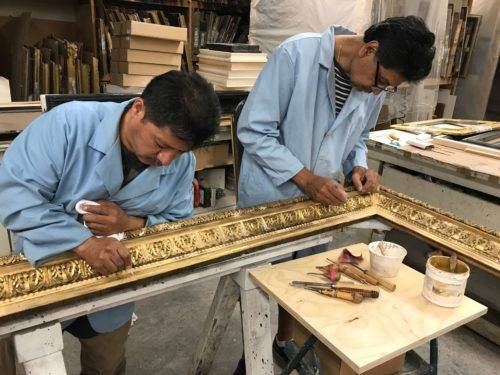 Menu
Menu
Posted: October 8, 2017
For years HCF staff members have longed to restore the beautifully ornate frames surrounding the Madonna of the Chair and Romeo and Juliet paintings in the Aiken-Rhett collection.
Over 150 years of general wear and tear had taken their toll, and the frames were in desperate need of repair. In fact, the frame around Luther Terry’s Romeo and Juliet was so damaged that it had to be removed from the gallery in 2015. A generous grant from Eli Wilner & Company made the restoration possible. Wilner, located in Queens, NY, is the leading expert in frame restoration. Among its clients are The White House and the Metropolitan Museum of Art where Wilner replicated the immense frame for Washington Crossing the Delaware by Emanuel Leutze for the MET’s American Wing — a $2.5 million project.
While frames have garnered little attention from curators and collectors in the past, they are now experiencing a newfound appreciation. Although frames are primarily thought to highlight and draw attention to the paintings they enhance, many are often valued as much, if not more, than the paintings themselves. Preserving frames such as these honors the artist’s original aesthetic intention and adds to the historic value of the painting.

The craftsmen of Eli Wilner & Company have mastered the same techniques and materials used to produce the original frames in order to achieve the best results. This process of frame restoration includes attention to three major components – the structural support, the surface decoration, and the gilded surface. The surface decoration is usually the most time consuming and often consists of several layers of design elements including ornamentation and gilded surface. The ornamentation is either cast from existing molds or hand-crafted. The gilding process is also a tedious task in which gold leaf is carefully applied to a gessoed surface (a prepared surface of plaster or plaster like material for painting, gilding, etc.).
These mid-19th-century frames are works of art themselves, each hand-crafted and gilded with elaborate ornamentation. We look forward to re-hanging them in the Art Gallery at the Aiken-Rhett House Museum in late October.
This is fantastic! I have long appreciated antique frames as works of art, and friends have been puzzled by my “art” collections which seem to have no theme, before I explain they should be admiring the frames! So glad to hear of this undertaking!
Will there be any talks offered on the history of the frame designers?
regards,
Susan
Hi. We love these frames, too! Unfortunately, we do not know anything about the craftsmen who constructed the frames. These were bought by the Aikens on their “Grand Tour” in the 1850s.